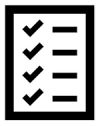Objectives
By the end of this module, you should be able to
- Understand the ideation process
- Implement the ideation process to develop your own startup idea
Ideas are a strange thing. On the one hand, ideas are a “dime a dozen” – we all have ideas! It is only the execution of an idea that sets it and the entrepreneur apart from others. On the other hand, the lack of a good idea is often cited as one of the main reasons that aspiring entrepreneurs never start a business. This module looks at sources of good ideas, and how you can conduct an ideation session to try expose your inner creativity! As you might guess, this should not be a hurdle that keeps you from starting your business.

This question has been around for some time and discussed from many different angles. One researcher, Steve Johnson as made several conclusions on this matter. His conclusions are outlined in the video below. As you will see, he found that the source of good ideas come from the environments in which we put ourselves.
Other research affirms this view, saying that good ideas come to us sometimes by chance – or by serendipity. Serendipity is a combination of searching for an idea, having the knowledge to recognize when a good idea presents itself, and for a happy accident to occur. This strand of research says that we must place ourselves in situations that encourage serendipitous discovery. For example, by “putting ourselves out there” by talking with others, and through listening and collaborating with them, we are much more likely to serendipitously come up with a good idea. Authors of this view call this “planned luck”. What behaviors do you think might set you up to discover ideas in this way? How can you put yourself in more of these situations?
How about some more practical advice? A quick Google search gives a lot of suggestions which may help you out. From Forbes, the following article contains some of the ideas and concepts that we discuss in this course:

One resource to help generate ideas is Shopify’s blog and courses. These resources are particularly useful for those looking to sell a product or service online. This search can also be a daunting task, as there are countless products out there! However, this sales model can be useful for a market like Western Newfoundland. Not only have digital sales channels grown in popularity since COVID-19, they give entrepreneurs a chance to reach a larger market. Have a look at Shopify’s ways to find business ideas. You will see that there are may other resources at Shopify that are helpful for starting an online store. Just remember to do your own research after reading these articles. Shopify’s business model is to get more people selling online, so their aim is to make it look as easy as possible. While the barriers to entry can be low, make sure you do your homework and check other sources!
Ideation is the process whereby you can generate ideas through several brainstorming and other collaboration techniques. Born out of the design thinking process, ideation helps generate a large variety of ideas, get different perspectives from other people, ask different questions, and consider solutions to problems that are not obvious. The video below provides an interesting introduction to the ideation session:
Ideation argues that there are optimal methods to collaborate and generate ideas. Ideation also works well when you set out to tackle a specified problem. At this point, have a look at your activity from Module 1. What types of problems were you hoping to solve? Are there any types of skills, pass times, or marketable skills that you would like to employ? Is there a particular interest that you would like to build upon? What else arose from the assignment at the end of the module that sparked an idea? Take special note of these points – you may wish to use them as a starting point for your own ideation session.
Now it is time to run your own ideation session! Have a look at the articles below to help get you started, to help you get organized, and to conduct the session.

For this module, you should conduct your own ideation session with others. You can follow the steps below as a guide and use them alongside the sources above:
- Arrange for your group to meet virtually using a good collaborative software, or in person (if possible). If you need a boardroom or workspace, the Navigate program manager may be able to book you a space at College of the North Atlantic, Corner Brook Campus or Grenfell Campus.
- Consult your notes from your module 1 assignment. Write down a few problems you would like to solve, or some interests that you would like to engage in for your idea.
- Use some of the tools above to create as many ideas as possible – there are no bad ideas at this point, so everyone should speak freely and be silly!
- After you have made a large list, you may separate some ideas that are overly complicated. For example, you might want to separate the idea of “micro-brewery with beer delivery service” into the two ideas of “brewery” and “beer delivery service”. You may also see some ideas that can be combined. For example, if you have “walking tour provider” and “application”, you might be able to combine them as a blog on walking tours in Corner Brook.
- You may start to narrow down ideas that interest you or seem to be the most plausible. Once you have a manageable number, try and find consensus on one idea.
- What problem is this idea solving? What resources, skills, and contacts do you have to get started right away? Does this look like an idea you can take to the next step of the process? If so, then let’s move onto Module 4. If not, then try and conduct another session – don’t give up!

